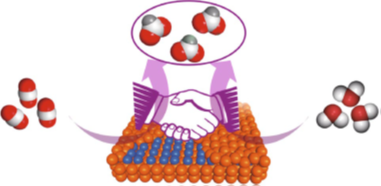Electrochemical CO2 reduction reaction (CO2RR) is considered an attractive route to energy and environmental sustainability. Based on techno-economic analysis, formate/formic acid is suggested to be one of the most economically profitable products at industrial scale through CO2RR. However, high faradic efficiency usually is limited to a very narrow potential window and cannot be maintained at high current density which is critical for industrial scale applications. Therefore, CO2RR to formate with high selectivity and high current density in a large potential range is of critical significance for the technology’s commercial viability. In a recent paper published in Nano-Micro Lett. (https://doi.org/10.1007/s40820-021-00772-7), Wu et al. applied boron (B) atoms to modify the local electronic structure of bismuth (Bi) catalyst. The strategy could boost CO2 conversion to formate with high activity and selectivity in a wide potential range.
In this work, B was intercalated on Bi to create a 3D porous structure. The morphology and electronic state of the catalyst were characterized by SEM, TEM, XPS, and XANES. Electrochemical measurements were conducted to evaluate the catalyst performance toward CO2RR to formate. Density functional theory (DFT) calculations were conduced to understand the reaction mechanisms.
Characterizations of morphology and electronic state of B doped Bi catalyst confirmed that B incorporation can tune the oxidation state of Bi in the Bi-B architectures. Then, electrochemical measurements were conducted on a representative B doped Bi catalyst (Bi-B2) and a control sample (Bi-H) to evaluate the catalyst performance. Based on the LSV results, it was found that the formate FE for Bi-B2 could maintain at > 95.1% in a large potential window, which outperforms many recently reported state-of-the-art Bi-based catalysts. The Bi-B2 also showed more than twice the current density of Bi-H under the same testing potential. When incorporated in a flow cell, the Bi-B2 catalyst showed a large current density of 222 mA cm-2 with stable formate selectivity of over 95% at -0.8V potential, which indicates great potential for commercial applications. The authors then conducted DFT calculations. Based on the calculation and experiment results, a mechanism of CO2RR on Bi-B was proposed.
This work provides a way to tailor the electronic property of materials and to develop highly active and selective CO2RR electrocatalysts toward formate, especially at more negative potentials. The strategy could be helpful for rational design of efficient CO2RR electrocatalysts using earth abundant, cost effective and environmentally friendly materials.


